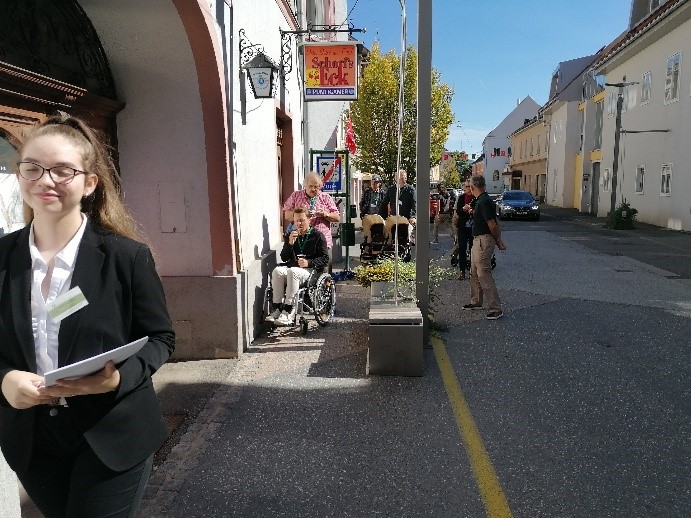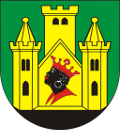Judenburg


Report
Event No.4
Judenburg, September 23th - 25th 2021
The project « ACTAGE - Juniors for seniors active ageing « is funded with the support of the European Union under the program "Europe for Citizens"
Participants:
The event involved 75 citizens from the participanting cities:
Judenburg/Austria: 40
Skofja Loka/Slovenia: 16
Bad Kötzting/Germany: 3
Bundoran/Ireland: 2
Susice/Czech Republic: 3
Rokiskis/Lithuania: 4
Köszeg/Hungary: 4
Meerssen/Nederlands: 3
The event in Judenburg focused on the topic of "Mobility and Accessibility for Seniors". The program was tailored to the target groups of officials (especially politicians) and senior citizens.
Opening
The congress was opened by Hannes Dolleschall, mayor of the City of Judenburg, Elke Florian, vice mayor of the City of Judenburg, Thorsten Wohleser, city councilor and organizer of "Douzelage" Judenburg, Annigje Krytbosch, president of "Douzelage" and Miha Jese, organizer of "Juniors for Seniors “- active aging.
Daniel Peter Gressl - the initiator of the Ö-Nurse Judenburg - an all-encompassing health consultancy and expert in the care sector, was invited as a key-note speaker. The topic of this speech was "Challenges of Aging", where the current development trend of senior citizens was presented and discussed. In particular, the needs of a so-called community nurse were addressed.

Workshop 1
The first workshop dealt with the current situation in the participating cities. This includes, in particular, suggestions for improvement and existing obstacles for the elderly and, in particular, people with reduced mobility, as well as “best practice” examples from the participating cities.
The main tenor was that all cities have similar problems. -> For example, there are lanterns / lamps in the way or there are potholes and bumps. According to the participants, the environmental concept is also related to the topic of "accessibility". To this end, some cities have significantly reduced the cost of public transport for seniors.
As a prime example: in Skofja Loka you can use certain public transport for free on shorter journeys.
Even if one cannot directly compare the circumstances and legal requirements of the individual states/cities, a few things could already be changed by using small resources. Another example is the planning of own “senior bus stations” near the city center and also lowering the boarding level of the means of transport. "Disabled people" would be happy about more handicapped accessible ways and are very grateful for support. These people are only able to cope with this to a limited extent in their everyday life and are therefore severely disadvantaged.
Each participating city has prepared a lecture for this purpose, with the presentations of the individual cities being attached.

Workshop 2
This workshop was carried out according to the principle of “learning by doing”. Four routes were defined in which the participants had the opportunity to overcome barriers themselves in a wheelchair, a walker, a stroller and using glasses for being blind. Best practice examples from the host city of Judenburg were tested and insurmountable obstacles were perceived. This close-up approach was received very positively and was able to make the extremely important topic tangible in a very informative way and generated quite a few AHA experiences! In the subsequent discussion rounds, these experiences could be exchanged and documented.
The main findings of this workshop were:
- There are obstacles that can be removed with simple means. (e.g. Vinzimarkt ramp, uncoordinated poster stands)
- There are barrier-free facilities that do not work because there are small technical deficiencies (e.g. lift at the local post office)
- There are barrier-free facilities that cannot be classified as barrier-free due to a lack of information. (BF public toilet)
- There are barriers that cannot be removed or can only be removed with uneconomical effort. There are regulations for this, but there are also alternative solutions. (Paths with large differences in height, higher entrances directly to the public property, etc.)
- The topic is still not anchored in people's minds, it needs a continuous and target-oriented information channel.
The following measures can be set out as concrete steps from this workshop:
- Further direct inspections with all stakeholders (people with disabilities and decision-makers)
- Evaluation of the city centers for quick win solutions
- Creation of an action plan with regard to the results
- Implementation of an action plan and the Quick win findings
- Creation of a barrier-free guide for entrepreneurs and Entrepreneurs as well as for the public space (traffic / squares / paths and housing)
- information campaigns
- acoustic signals at traffic lights are not available and can be a problem for blind people.
Tenor: Accessibility serves us all! Stepless entrances and good information as well as orientation represent added value not only for people with disabilities and the elderly, but are the basic prerequisite for micromobility, families with prams and everyone who wants to use a city that is liveable and future oriented.
Workshop 3
The two focus groups “Officials” and “Seniors” were divided into two working groups. The findings of the individual participating cities from workshop 1 and from the city walk from workshop 2 were discussed and specific applications for the individual cities were derived.
The bottom line is that a lot is taken for granted. The change in the age structure (note: people are getting older) must be incorporated into the planning of the future in order to identify and solve problems relating to micro-mobility and accessibility as soon as possible. The experience of the “Citywalk with Obstacles - Workshop 2” was important for all participants, because certain obstacles could only be understood through direct experience.
Another conclusion was that barriers for disabled people need to be removed. These changes must continue to be checked, updated and improved on an ongoing basis. Small improvements can make a big contribution to making everyday life easier. It would be extremely important to get larger groups of people (old & young) excited about this topic and to encourage them to improve.
In conclusion, it can be said that the participating cities have already developed an awareness of the topic of “mobility (in old age or with disabilities)”, but there are still many opportunities for improvement. Here, too, the tenor was established that all steakholders (disabled people, elderly people, politicians ...) should check the cities for their accessibility at regular intervals. We do this together based on individual circumstances and not on the basis of stuck patterns.
Actuality: Much of what is still state-of-the-art today may already be out of date in a few years, especially with high investment sums and large structural measures, it is important to incorporate these developments as best as possible.
Concretely defined measures and advice:
- The “city walk” model should be used regularly in all cities
- Barrier-free guidelines should be established in cities, so citizens should be involved in building measures as well as possible.
- Accessibility must be incorporated into urban development concepts as a fixed point - Financing and subsidies pose great challenges for many municipalities, and there are also enormous differences between the individual states and cities.
- Changes in the age structure must be considered when you are developing cities
- Cycle paths and sidewalks must be state-of-the-art
- Public transport stations should be checked for suitability and accessibility
- Public transport (keyword: entrances) is often a major problem
- Public toilets are a major problem. They either do not exist, are closed or are not accessible. The sanitary facilities in Europapark in Judenburg can be cited as a positive example.
- Gutters and manhole covers are often an insurmountable obstacle and should be checked for their accessibility.
- Due to their height and size, machines and post boxes are often inaccessible by people.
- Floor markings are a potential source of danger, especially when it is wet
- Decorative objects often pose a problem for prams and wheelchairs.
- Many ramps are often blocked with other objects (e.g. rubbish bins)












